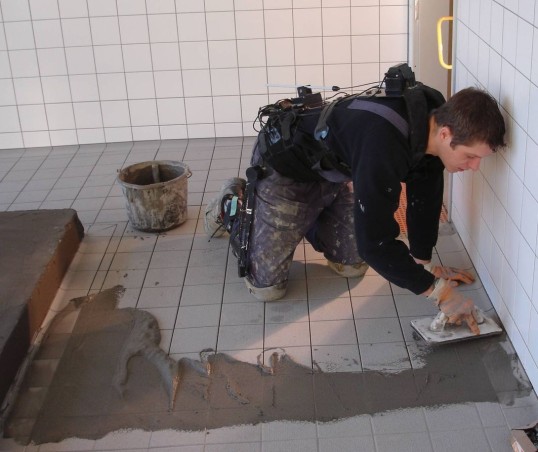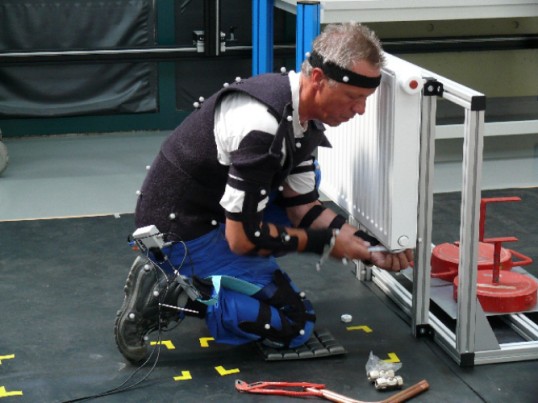- Artificial Intelligence (AI)
- Occupational exposure limit values
- Climate Change and Occupational Safety
- List of CMR substances
- Electromagnetic fields
- Ergonomics
- Industrial Security
- Collaborative robots
- Noise
- Nanoparticles at the workplace
- Optical Radiation
- REACH
- Reference materials
- Proficiency testing
- Vibration
- Virtual reality
- Work 4.0
Laboratory and field research projects conducted at the IFA concerning tasks placing stresses upon the knee
Metrological analyses of occupational knee stresses
Occupational stresses arising during work performed whilst kneeling, squatting or crawling are among the factors associated with a risk of disease of the knee joints, such as osteoarthritis or diseases of the meniscus. In order for suitable measures to be taken to prevent these conditions, comprehensive knowledge is required of the specific stress situations at workplaces. At the Institute for Occupational Safety and Health of the DGUV (IFA), a number of research projects have been launched for study of the incidence of occupational knee stresses in practice, and of their specific stress parameters.
In conjunction with a number of individual accident insurance institutions, knee stresses have consequently been recorded in detail in 16 occupations and approximately 80 different tasks in a field study (GonKatast register of measured values for tasks placing stress upon the knees). The studies were conducted with the aid of the CUELA system of computer-assisted measurement and long-term analysis of musculoskeletal workloads.
Besides the duration of daily knee stress occurring in different tasks, these studies also recorded data on the nature, duration and frequency of individual stress situations, and results for the symmetry of the knee stress and the magnitude of the knee angle. The metrological studies were supported by a questionnaire, permitting comparison of the results of the two. Biomechanical studies of body postures placing stress upon the knee were also conducted in the laboratory. The development of a biomechanical knee model enabled the joint forces in the knee in different postures such as kneeling, squatting and sitting seiza-style to be determined and placed in a stress context, both in sustained static tests and during practical tasks (such as tiling work, see information sheet 0308 (PDF, 283 kB, non-accessible) ).
In field studies, the tasks were identified for which prevention measures for reduction of the stress upon the knee appear advantageous. The objective in the first instance was to take suitable measures to avoid squatting or kneeling postures, or to reduce their scale, whether by means of aids, adjustment of the working height, or organizational measures. Sector-specific recommendations made available in the report on lifting and carrying, activities performed in a kneeling position and with constrained postures in the interior decoration trade (BGIA-Report 1/2007) may serve as specific examples of such measures (see information sheet 0267 (PDF, 140 kB, non-accessible) ).
The laboratory analyses also showed kneeling down and standing up from the ground and standing with the knees bent to be situations associated with the greatest stress upon the knee. An objective of effective prevention measures must therefore be to reduce the frequency of these procedures. In addition, the wearing professional knee protection (such as knee protectors or pads) should be regarded as mandatory for all tasks performed in a kneeling posture.
Further information

GonKatast – Ein Messwertkataster zu beruflichen Kniebelastungen (GonKatast - A measured value register of occupational knee stress)
IFA-Report 1/2010 (in German)
Erfassung arbeitsbedingter Kniebelastungen in ausgewählten Berufen (Survey on work-related knee-straining activities in selected occupations)
IFA Report 2/2012 (in German)
Heben und Tragen, kniende Tätigkeiten und Zwangshaltungen im Raumausstatterhandwerk (Lifting and carrying, tasks performed in a kneeling position and constrained posture in the interior design trade)
BGIA-Report 1/2007 (in German)
Biomechanical stress analysis of squatting and kneeling postures
Focus on IFA's work No 0308 (PDF, 283 kB, non-accessible)
Code of practice: avoidance of musculoskeletal diseases amongst interior decorators
Focus on IFA's work No 0267 (PDF, 140 kB, non-accessible)

